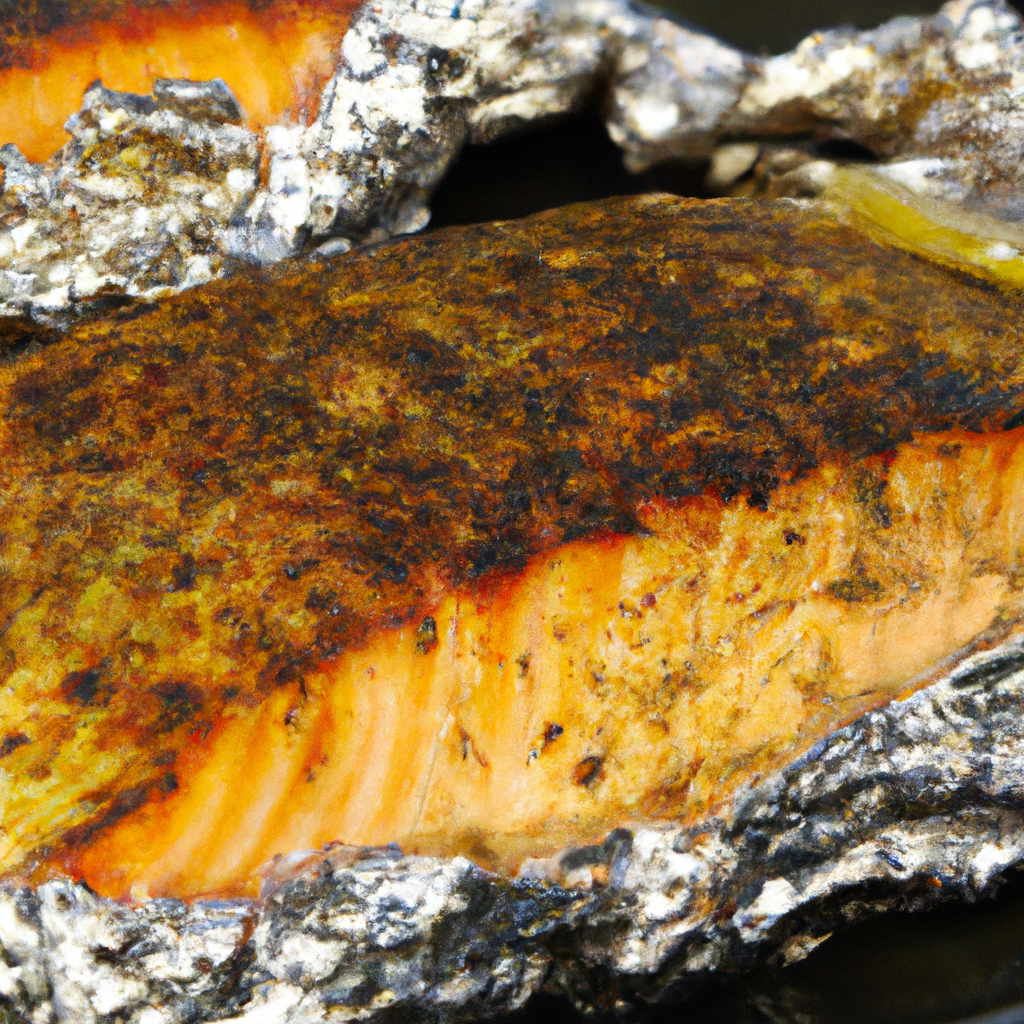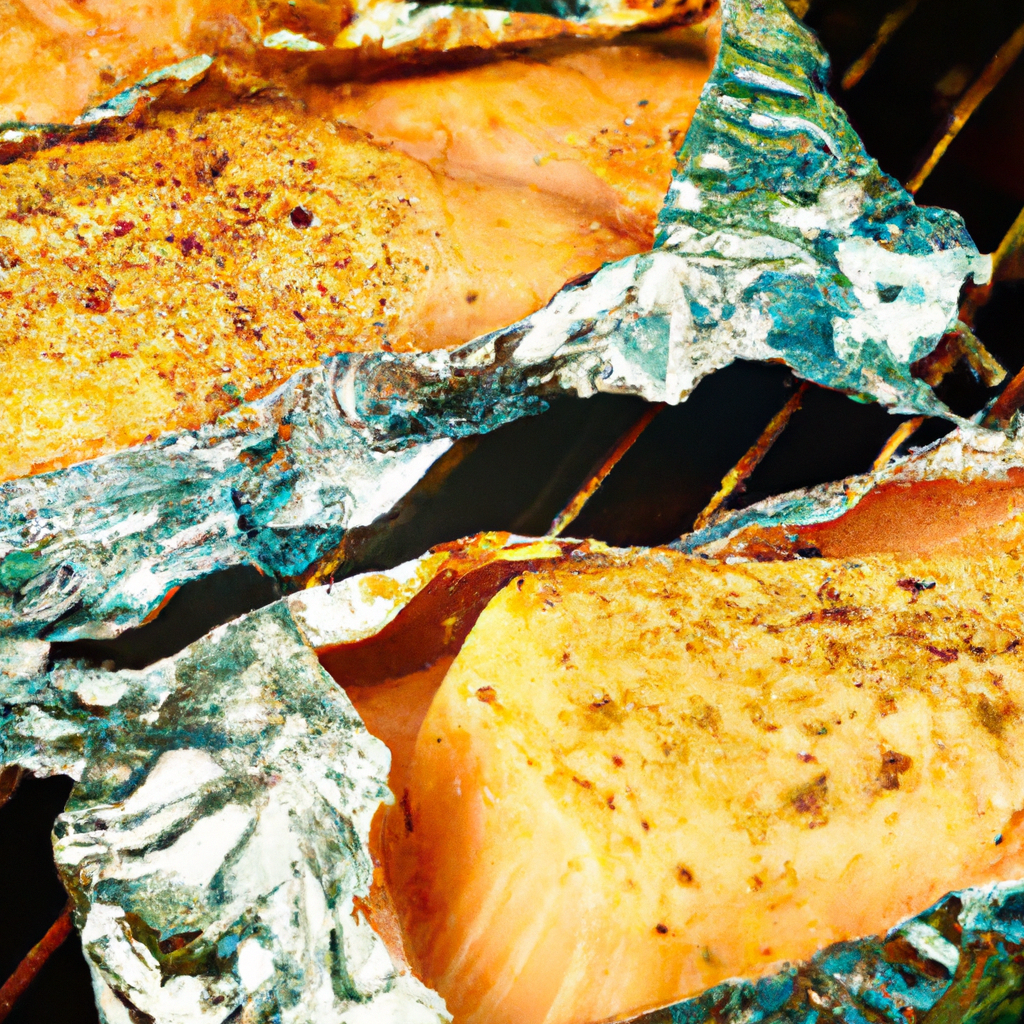Grilling salmon in foil is not only a delicious way to enjoy this nutritious fish, but it also keeps the flesh moist and flavorful. But the burning question remains: how long does it actually take to grill salmon in foil to perfection? Fear not, because in this article, you will discover the answer to this culinary conundrum. We’ll explore the ideal cooking time, factors that can affect it, and even some handy tips to ensure your foil-wrapped salmon comes out tender, moist, and bursting with flavor. Get ready to elevate your grilling game and impress your friends and family with delectable grilled salmon in foil!
Preparing the Salmon
Selecting the Salmon
When preparing salmon for grilling, it’s important to start with a fresh and high-quality piece of fish. Look for salmon fillets that are firm and moist, with a vibrant pink color. Whether you choose wild-caught or farm-raised salmon is a matter of personal preference, but make sure to check the sustainability and source of the fish.
Seasoning the Salmon
Before grilling, season your salmon fillets to enhance their flavor. You can keep it simple with just salt and pepper, or get creative and use a variety of herbs and spices. Some popular options include garlic powder, paprika, dill, or lemon zest. Whether you choose a dry rub or a marinade, be sure to let the flavors infuse into the salmon for at least 30 minutes before grilling.
Preparing the Foil
Grilling salmon in foil is a fantastic method to keep the fish tender and juicy. Start by tearing a large piece of aluminum foil and folding it in half to create a double layer. Spray the foil with non-stick cooking spray to prevent the salmon from sticking. Place the seasoned salmon fillets in the center of the foil, leaving enough space around the edges to fold and seal the foil packet.
Preheating the Grill
To ensure a perfectly grilled salmon, it’s important to preheat your grill. Preheating helps to achieve even cooking and prevents the salmon from sticking to the grill grates. Heat the grill to medium-high heat and allow it to warm up for about 10-15 minutes. This will give you the ideal grilling temperature for the salmon.
Grilling Time
Determining Thickness
The thickness of your salmon fillets plays a significant role in determining the grilling time. Thicker cuts will take longer to cook than thinner ones. As a general rule, measure the thickest part of the fillet and grill for about 10 minutes per inch of thickness. This will give you a rough estimate, but it’s always best to rely on visual cues and internal temperature to determine doneness.
General Cooking Time
On average, salmon fillets will take around 15-20 minutes to cook on the grill. However, this may vary depending on the size and thickness of the fillets, as well as the desired level of doneness. It’s important to remember that salmon should be grilled until it reaches an internal temperature of 145°F (63°C) for optimal safety and taste.
Variations for Doneness
Grilled salmon can be prepared to different levels of doneness to cater to individual preferences. For a medium-rare salmon, aim for an internal temperature of around 125°F (52°C). If you prefer a medium to medium-well doneness, target a temperature between 130°F (54°C) to 140°F (60°C). Be careful not to overcook the salmon, as it can become dry and less flavorful.
Checking for Doneness
To check for doneness, insert an instant-read thermometer into the thickest part of the fillet. The internal temperature should read 145°F (63°C) to ensure the salmon is fully cooked. Another way to check doneness is by gently pressing the salmon with a fork or your finger. If the flesh easily flakes and separates, it is ready to be taken off the grill.

Different Grilling Techniques
Direct Heat Method
The direct heat method involves placing the salmon fillets directly over the flames or heat source on the grill. This technique is perfect for achieving a nicely seared exterior and a slightly smoky flavor. Remember to adjust the heat and monitor the fillets closely to prevent burning.
Indirect Heat Method
The indirect heat method is ideal for grilling delicate salmon fillets as it provides a gentler cooking environment. To use this technique, set up your grill for two-zone cooking. Place the salmon on the side of the grill without direct heat, allowing it to cook slowly and evenly. This method is particularly useful when grilling thicker cuts of salmon.
Cedar Plank Method
Grilling salmon on a cedar plank imparts a unique smoky flavor and helps to keep the fish moist during cooking. Soak the cedar plank in water for at least one hour before grilling to prevent it from catching fire. Place the seasoned salmon fillets on the soaked plank and cook over medium heat, allowing the salmon to absorb the rich aroma of the cedar.
Hobo Pack Method
The hobo pack method involves wrapping the seasoned salmon fillets in foil, creating a sealed packet. This method is excellent for cooking delicate fish and allows for easy cleanup. Simply place the foil packet on the grill and cook over medium heat. The steam trapped inside the packet will help to keep the salmon moist and tender.
Factors Affecting Grilling Time
Salmon Thickness
The thickness of the salmon fillets directly impacts the grilling time. Thicker cuts will require a longer cooking time, while thinner fillets will cook more quickly. Remember to adjust the cooking time accordingly and monitor the doneness using a thermometer or visual cues.
Grill Temperature
Grilling salmon at the proper temperature is crucial for achieving the desired results. Cook the salmon over medium-high heat for the best balance of flavor and texture. If the grill is too hot, the salmon may char on the outside while remaining undercooked on the inside. On the other hand, cooking at low heat may result in overcooked and dry salmon.
Cooking Equipment
The type and quality of your grill can also affect the grilling time. Gas grills tend to provide more precise temperature control, while charcoal grills offer a smokier flavor profile. Make sure your grill grates are clean and well-maintained to prevent any sticking or uneven cooking.
Environmental Factors
External factors like weather conditions can also influence the grilling time. Wind can affect the temperature control of your grill, so keep an eye on the flames and adjust accordingly. Additionally, grilling at higher altitudes may require longer cooking times due to the lower atmospheric pressure.

Safety Tips
Proper Handling and Storage
When handling raw salmon, it’s essential to follow proper food safety practices. Keep the fish refrigerated until ready to cook, and be mindful of cross-contamination by using separate cutting boards and utensils for raw and cooked foods. Store any leftovers in the refrigerator within two hours of cooking.
Avoiding Cross-Contamination
To avoid the risk of foodborne illnesses, make sure to thoroughly clean all surfaces, utensils, and hands that come into contact with raw salmon. Wash your hands with soap and water for at least 20 seconds before and after handling the fish. This will help prevent the transfer of bacteria and keep your cooking area safe.
Maintaining Grill Safety Guidelines
Grilling can be a fun and enjoyable experience, but it’s crucial to prioritize safety. Follow the manufacturer’s instructions for your specific grill model and place it on a stable, non-flammable surface. Keep a fire extinguisher nearby and never leave the grill unattended. Remember to use long-handled tools and oven mitts to avoid burns.
Marinades and Glazes
Marinade Preparation
Marinades are a great way to infuse flavor into grilled salmon. To prepare a marinade, combine your choice of ingredients like citrus juices, soy sauce, vinegar, garlic, herbs, and spices. Place the salmon fillets in a shallow dish or resealable bag and cover them with the marinade. Allow the salmon to marinate in the refrigerator for at least 30 minutes, or up to overnight.
Applying Marinade to Salmon
When applying the marinade to the salmon, ensure that the fillets are evenly coated on both sides. If using a zip-top bag, gently massage the marinade into the fish, allowing it to penetrate the flesh. For a more intense flavor, reserve a portion of the marinade to brush onto the salmon while grilling.
Choosing a Glaze
Glazes are a delicious way to add a glossy finish and extra flavor to grilled salmon. Popular glaze options include honey mustard, teriyaki, maple syrup, or balsamic reduction. You can make your own glaze by combining the desired ingredients and reducing them to a thick consistency on the stove. Store-bought glazes are also widely available and can be used for convenience.
Applying Glaze to Salmon
To apply the glaze, brush it onto the salmon during the last few minutes of grilling. This will allow the glaze to caramelize and create a beautiful, flavorful coating on the salmon. Apply multiple layers of glaze if desired, ensuring that each layer has time to set before adding another.
Serving Suggestions
Accompaniments and Sides
Grilled salmon pairs well with various accompaniments and sides. Serve it alongside a fresh salad with a tangy vinaigrette, roasted vegetables, or grilled asparagus for a vibrant and nutritious meal. You can also prepare a side of fluffy quinoa, buttery mashed potatoes, or a refreshing cucumber and dill yogurt sauce for a complete dining experience.
Garnishing Options
Garnishing grilled salmon adds an extra touch of visual appeal and flavor. Consider topping your salmon with fresh herbs like dill, parsley, or chives for a burst of freshness. Additionally, a squeeze of lemon juice over the fillets can enhance the natural flavors and provide a subtle tanginess.
Serving Temperature
Salmon can be served warm, at room temperature, or chilled, depending on your preference and the dish you are preparing. Many enjoy the flaky and tender texture of warm grilled salmon, while others prefer the coolness of chilled salmon in salads or sandwiches. Experiment with different serving temperatures to find your favorite way to enjoy grilled salmon.
Alternative Methods of Cooking Salmon
Baking in Foil
If you don’t have a grill or prefer to cook indoors, baking salmon in foil is an easy and flavorful alternative. Follow similar steps to preparing the foil packet, but instead of grilling, place the packet on a baking sheet and cook in a preheated oven at 375°F (190°C) for about 15-20 minutes. The foil will help seal in the moisture and infuse the salmon with the chosen seasonings.
Grilling without Foil
While grilling salmon in foil helps to prevent sticking and maintain moisture, it’s not the only way to enjoy grilled salmon. For direct heat grilling, make sure your grill grates are clean and well-oiled. Place the seasoned salmon fillets directly on the preheated grill and cook for the recommended time, flipping halfway through. Monitor the fillets closely to prevent sticking and cook to your desired doneness.
Pan-Seared Salmon
Pan-searing is a quick and delicious method for cooking salmon. Heat a tablespoon of oil in a skillet over medium-high heat. Once the oil is hot, place the seasoned salmon fillets in the skillet, skin-side down if applicable, and cook for about 4-5 minutes per side. The salmon should be nicely browned on the outside and tender on the inside. Adjust the cooking time based on the thickness of the fillets.
Poached Salmon
Poaching salmon yields a delicate and moist result. To poach salmon, fill a large pot with water or a flavorful broth and bring it to a gentle simmer. Carefully place the seasoned salmon fillets into the liquid and cook for about 10-12 minutes, depending on the thickness. Remove the salmon from the liquid and let it rest for a few minutes before serving.
Tips and Tricks
Using a Fish Basket
Grilling delicate salmon fillets can be challenging without the risk of them falling apart or sticking to the grates. Using a fish basket is a helpful tool to ensure even cooking and prevent the fish from breaking apart. Simply place the seasoned salmon fillets in the basket and grill as usual. The basket allows for easy flipping and removes the worry of losing any portions of the fish.
Using a Thermometer
Investing in an instant-read thermometer is a game-changer when it comes to grilling salmon. It provides an accurate and reliable way to determine the doneness of the fish, ensuring it is cooked to perfection. Insert the thermometer into the thickest part of the fillet, away from the bone if applicable, and check the temperature for your desired level of doneness.
Avoiding Overcooking
Salmon is best enjoyed when it is moist and flaky, so be cautious not to overcook it. Remember that the salmon will continue to cook slightly even after being removed from the grill. To prevent overcooking, consider removing the salmon from the grill when it is slightly under the desired doneness and let it rest for a few minutes. The residual heat will gently finish the cooking process.
Achieving Grill Marks
Grill marks not only add visual appeal but also enhance the flavor of your grilled salmon. To achieve those coveted grill marks, preheat your grill grates and brush them with oil to prevent sticking. Place the salmon fillets perpendicular to the grates and allow them to cook undisturbed for a few minutes before carefully rotating them 45 degrees using tongs. This will create the distinct crosshatch pattern.
Conclusion
Grilling salmon in foil is a fantastic way to enjoy a tender, moist, and flavorful dish. By following the proper techniques, seasoning the salmon to your taste, and monitoring the grilling time, you can achieve a perfect result every time. Whether you prefer the direct heat method, the indirect heat method, or experimenting with different marinades and glazes, there are endless possibilities to explore. So fire up the grill, select the finest salmon fillets, and get ready to enjoy a delicious grilled salmon feast that will impress your family and friends. Happy grilling!

